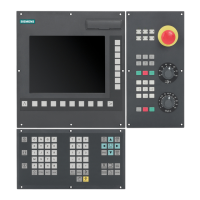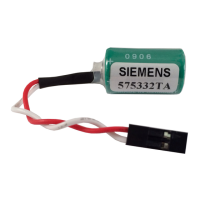Path traversing behavior
9.1 Tangential control (TANG, TANGON, TANGOF, TANGDEL)
Job planning
Programming Manual, 03/2006 Edition, 6FC5398-2BP10-1BA0
9-3
TANGDEL Delete definition of a tangential follow-up
An existing user-defined tangential follow-up must be deleted if a new tangential follow-up
with the same following axis is defined in the preparation call TANG. Deletion is only possible
if the coupling with TANGOF(Faxis) is deactivated.
Parameters
TANG Preparatory statement for the definition of a tangential
follow-up; default setting: 1
TANG(C,X,Y,1,"B") means:
Rotary axis C follows geometry axes X and Y. Disable TLIFT
TANGON Activate tangential control specifying following axis and
required offset angle of the following axis and, if
necessary, rounding path, angle deviation.
TANGON(C,90) means:
C axis is the following axis. On every movement of the path
axes, it is rotated into a position at 90° to the path
tangent.
TANGOF Deactivate tangential control specifying following axis.
The following axis is specified in order to deactivate the
tangential control:
TANGOF(C)
TLIFT Insert intermediate block at contour corners
TANGDEL Delete definition of a tangential follow-up.
Example: TANGDEL (FAxis)
Faxis Following axis: additional tangential following rotary axis.
Laxis1, Laxis2 Leading axes: path axes, which determine the tangent for the
following axis.
Coupling Coupling factor: relationship between the angle change of the
tangent and the following axis.
Parameter optional; default: 1
CS Identifying letter for coordinate system
"B" = Basic coordinate system; entry is optional; default
setting "W" = Workpiece coordinate system is not available
Opt Optimization:
"S" Standard, Default
"P" automatic adaptation of the time change of the
tangential axis and the contour
Angle Offset angle of following axis
Dist Smoothing path of following axis, required with Opt "P"
Angletol Angle tolerance of following axis, (optional), evaluation
only with Opt= "P"
Opt, Dist and Angletol optimization possibility
Opt="P" specifies that the dynamic behavior of the following axis for the speed limitation
of the leading axes and, in particular, is recommended when kinematic transformations are
used.
The parameters (Dist and Angletol) limit the error between the following axis and the
tangent of the leading axes precisely.

